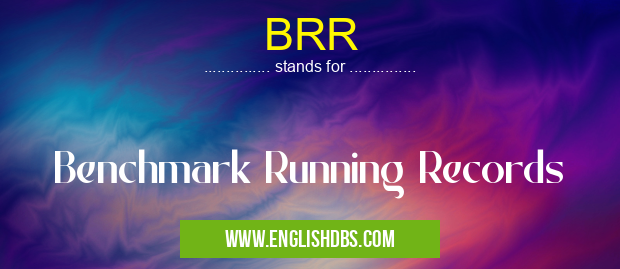What does BRR mean in UNCLASSIFIED
BRR stands for Benchmark Running Records. It is a form of informal assessment used in education to measure students' reading fluency and comprehension.

BRR meaning in Unclassified in Miscellaneous
BRR mostly used in an acronym Unclassified in Category Miscellaneous that means Benchmark Running Records
Shorthand: BRR,
Full Form: Benchmark Running Records
For more information of "Benchmark Running Records", see the section below.
BRR Process
BRR involves a teacher or reading specialist observing a student reading a graded text at their instructional level. The teacher records the student's accuracy, rate, and comprehension. This data is then used to determine the student's reading level and identify areas for improvement.
Key Components
- Accuracy: Number of words read correctly out of the total words attempted.
- Rate: Number of words read correctly per minute.
- Comprehension: Student's understanding of the text, measured through questions or retelling.
Benefits of BRR
- Quick and Efficient: Provides an assessment within a short time frame.
- Individualized: Tailored to the student's specific reading level.
- Data-Driven: Provides concrete data for monitoring progress and making instructional decisions.
- Early Identification: Helps identify students with potential reading difficulties at an early stage.
Limitations of BRR
- Subjective: The assessment is based on the teacher's observations and can vary between different observers.
- Not Comprehensive: Does not assess all aspects of reading fluency, such as prosody or expression.
- May Not Reflect Authentic Reading: Students may perform differently when reading for a specific assessment.
Essential Questions and Answers on Benchmark Running Records in "MISCELLANEOUS»UNFILED"
What are Benchmark Running Records (BRRs)?
Benchmark Running Records (BRRs) are standardized, comprehensive measurements of student reading growth and performance. They assess a student's reading ability at specific points in time, providing a snapshot of their progress and identifying areas for improvement.
How are BRRs used?
BRRs are used to:
- Monitor student reading growth over time
- Identify students who need additional support or intervention
- Plan and adjust reading instruction based on student data
- Measure the effectiveness of reading programs and interventions
What skills do BRRs measure?
BRRs assess a range of reading skills, including:
- Accuracy and fluency
- Vocabulary and comprehension
- Text structure and organization
- Phonics and decoding
How often are BRRs administered?
The frequency of BRR administration varies by school or district. They are typically administered at least once or twice per year, at predetermined intervals.
Who administers BRRs?
BRRs are typically administered by certified reading specialists or trained educators who have been trained in the specific BRR system being used.
How are BRRs interpreted?
BRR results are interpreted using benchmarks or cut scores that indicate the expected level of performance for different grades and ages. They are typically presented in the form of a graph or chart that shows a student's progress over time.
What are the benefits of using BRRs?
BRRs provide a number of benefits, including:
- Early identification of students who need support
- Data-driven decision-making for reading instruction
- Tracking student progress over time
- Measuring the effectiveness of reading programs
Final Words: BRR is a valuable tool for educators to assess students' reading fluency and comprehension. By providing data on accuracy, rate, and comprehension, BRR helps teachers monitor progress, identify areas for improvement, and make informed instructional decisions. However, it is important to recognize the limitations of BRR and use it in conjunction with other assessments to obtain a comprehensive understanding of students' reading abilities.
BRR also stands for: |
|
| All stands for BRR |
